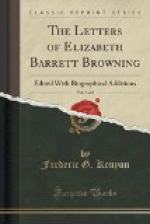[Footnote 3: These estates still remain in the family, and Mr. Charles Barrett, the eldest surviving brother of Mrs. Browning, now lives there.]
The family of Mr. Edward Barrett was a fairly large one, consisting, besides Elizabeth, of two daughters, Henrietta and Arabel, and eight sons—Edward, whose tragic death at Torquay saddened so much of his sister’s life, Charles (the ‘Stormie’ of the letters), Samuel, George, Henry, Alfred, Septimus, and Octavius; Mr. Barrett’s inventiveness having apparently given out with the last two members of his family, reducing him to the primitive method of simple enumeration, an enumeration in which, it may be observed, the daughters counted for nothing. Not many of these, however, can have been born at Coxhoe; for while Elizabeth was still an infant—apparently about the beginning of the year 1809—Mr. Barrett removed to his newly purchased estate of Hope End, in Herefordshire, among the Malvern hills, and only a few miles from Malvern itself. It is to Hope End that the admirers of Mrs. Browning must look as the real home of her childhood and youth. Here she spent her first twenty years of conscious life. Here is the scene of the childish reminiscences which are to be found among her earlier poems, of ‘Hector in the Garden,’ ‘The Lost Bower,’ and ’The Deserted Garden.’ And here too her earliest verses were written, and the foundations laid of that omnivorous reading of literature of all sorts and kinds, which was so strong a characteristic of her tastes and leanings.
On this subject she may be left to tell her own tale. In a letter written on October 5, 1843, to Mr. R.H. Horne, she furnishes him with the following biographical details for his study of her in ’The New Spirit of the Age.’ They supply us with nearly all that we know of her early life and writings.
’And then as to stories, my story amounts to the knife-grinder’s, with nothing at all for a catastrophe. A bird in a cage would have as good a story, Most of my events, and nearly all my intense pleasures, have passed in my thoughts. I wrote verses—as I dare say many have done who never wrote any poems—very early; at eight years old and earlier. But, what is less common, the early fancy turned into a will, and remained with me, and from that day to this, poetry has been a distinct object with me—an object to read, think, and live for. And I could make you laugh, although you could not make the public laugh, by the narrative of nascent odes, epics, and didactics crying aloud on obsolete muses from childish lips. The Greeks were my demi-gods, and haunted me out of Pope’s Homer, until I dreamt more of Agamemnon than of Moses the black pony. And thus my great “epic” of eleven or twelve years old, in four books, and called “The Battle of Marathon,” and of which fifty copies were printed because papa was bent upon spoiling me—is Pope’s Homer done over again, or rather undone; for, although a curious production for a child, it gives evidence




